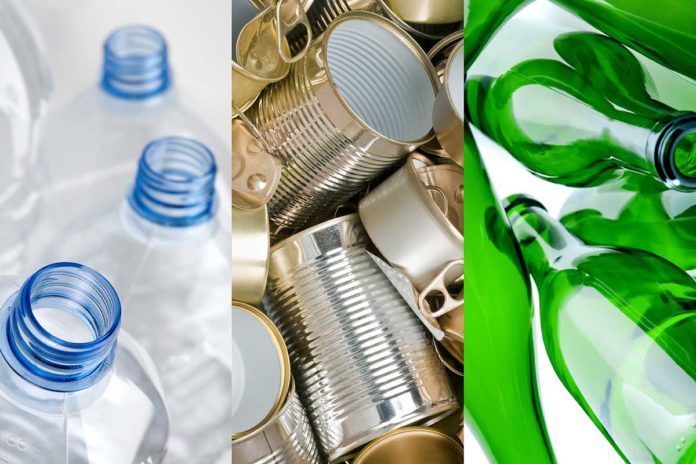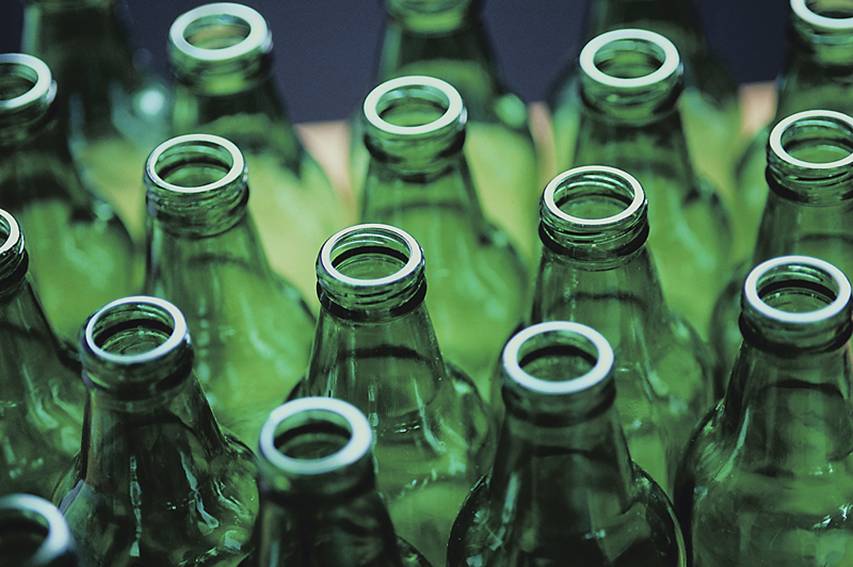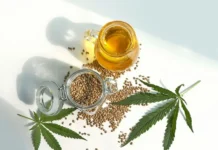
Product packaging is as important to sales as any other form of marketing. Depending on the product and audience, packaging may need to be environmentally-friendly, colourful, sophisticated, tamper-resistant, or resistant to sunlight. On average 9% of a product’s cost is the packaging it comes in. Here we take a look at the similarities and differences in the environmental impacts of plastic, aluminium, and glass packaging.
Plastic

Plastic is preferred as a packaging material by many manufacturers because of its low cost and versatility. Plastic packaging options include bags, pouches, films, sleeves, hard shells, and bottles. The lightweight and high durability of plastics lower packaging and shipping costs, and can be used to create endless varieties of colourful, high-profile packaging.
Plastics are made from natural materials like coal, natural gas, and crude oil. The acquisition of these materials causes several health concerns in many regions, including water contamination from fracking. Additionally, these sources are not sustainable. This turns many manufacturers, who prefer sustainable sourcing practices, away from plastic packaging.
Relatively little energy is needed to create different kinds of plastic and to turn it into the many kinds of packaging materials. However, once these materials are made, they are generally only able to be “downcycled”. Downcycling is a type of recycling that results in a different product than the original because the quality of the resulting material isn’t adequate enough to use for the same product. That means more harmful acquisition is necessary to continue to create the desired packaging products.
Another concern about plastic packaging is disposal. Only 10% of plastic materials have been recycled in recent years. Plastics are fairly new material, but already take up 20% of landfill space in the United States. Burning plastics releases toxic fumes, so there are few options available for reducing the amount of plastic trash we continue to create.
Plastic packaging trash is often found in oceans and other bodies of water, killing and injuring marine wildlife. Avian creatures are also known to be hurt and killed by plastics, as are many land animals. Because plastic takes up to 500 years to fully decompose, these packaging products continue to cause devastation to environments all over the world.
Aluminum

Most commonly seen as beverage cans, aluminum packaging can include medical, food and condiment, and cosmetics. It’s also often used with an adhesive to create a seal that protects unopened products against tampering while preserving package contents. Aluminum packaging protects contents from moisture, sunlight, and other potentially damaging elements.
Aluminium is usually mined from Bauxite rock. The mining of Bauxite is destructive to many environments and causes irreversible damage like water contamination and accelerated erosion. Manufacturers who are looking for environmentally-friendly sourcing should consider alternatives to aluminium.
Like plastics, it can take up to 500 years for aluminium products to fully decompose. Fortunately, the realized recycling potential of aluminium is actually quite high. A recent analysis showed that 45% of aluminium cans are recycled, and the contents of United States landfills are only about 9% metal, a fraction of which is aluminium. Aluminium is 100% recyclable, meaning the quality of the resulting aluminium is high enough that it can be used again to make the same products. This cycle can be repeated endlessly with the same quality results.
When used in food, cookware, cosmetic, or personal care product packaging, it’s possible for aluminium to leech into the food, beverage, and other products. When ingested or applied by consumers, the aluminium can enter the brain bound to a protein called transferrin, which would normally carry iron throughout the body. This action has been linked to Alzheimer’s disease, Parkinson’s disease, various forms of dementia, and bone disease.
To prevent this leeching, most aluminium cans and bottles are lined with BPA plastic epoxy. During recycling, this lining is burned off and the aluminium packaging is recycled as normal. Burning this plastic lining releases toxins like hydrochloric acid, sulfur dioxide, dioxins, furans, heavy metals, and particulates. These toxins cause respiratory and immune system stress in humans and some are known carcinogens.
Glass

Glass packaging has been used since around 100 B.C. According to Mineral Milling, today, we use glass containers for beverages, cosmetics, food and condiments, candles, and personal care products. Glass is inert, which means it won’t react chemically to its contents, and it won’t leech into food or other consumables. It can also improve the perceived value of a product because glass is thought to be a higher-quality packaging option.
Glass requires more energy to manufacture than other packaging options because silica sand melts into the glass at 1700°C. Surface mining of the silica sand used to make most glass is slightly controversial. Safety precautions have to be carefully followed by anyone involved in silica sand mining and related manufacturing to avoid serious health issues caused by silica dust inhalation. Once the silica sand is melted into glass, it no longer poses a health risk. Surface mines like strip mines and open-pit mines are thought to lower property value and have a negative effect on tourism in tourist locations.
Like aluminium, glass is 100% recyclable. The same glass can be used endlessly to make the same type of packaging without any decrease in quality. This type of recycling allows manufacturers to use less energy in production because recycled glass has already been melted from silica sand. More than 33% of glass containers are recycled, and 80% of recovered glass containers are made into new glass containers. Glass makes up only 5% of the contents of United States landfills, despite the fact that it takes up to one million years for glass to fully decompose.
Because of its relatively benign sourcing tactics, lack of leeching-related health risks, and impressive recycling statistics, glass is the best packaging option for most manufacturers and retailers. Glass offers a sophisticated look and an inert container that won’t damage contents and has never been linked to any debilitating health conditions.
















